Detection of Gadolinium in Surrogate Nuclear Fuel Debris Using Fiber-Optic Laser-Induced Breakdown Spectroscopy under Gamma Irradiation
Abstract
1. Introduction
2. Materials and Methods
3. Results and Discussion
4. Conclusions
Author Contributions
Funding
Acknowledgments
Conflicts of Interest
References
- Nuclear Damage Compensation and Decommissioning Facilitation Corporation. Technical Strategic Plan 2019 for the Decommissioning of the Fukushima Daiichi Nuclear Power Station of Tokyo Electric Power Company Holdings, Inc.; Nuclear Damage Compensation and Decommissioning Facilitation Corporation: Tokyo, Japan, 2019. [Google Scholar]
- Ikeuchi, H.; Ishihara, M.; Yano, K.; Kaji, N.; Nakajima, Y.; Washiya, T. Dissolution behavior of (U, Zr) O2-based simulated fuel debris in nitric acid. J. Nucl. Sci. Technol. 2014, 51, 996–1005. [Google Scholar] [CrossRef]
- Nagatani, T.; Komeda, M.; Shiba, T.; Nauchi, Y.; Maeda, M.; Sagara, H.; Kosuge, Y.; Kureta, M.; Tomikawa, H.; Okumura, K. Characterization Study of Four Candidate Technologies for Nuclear Material Quantification in Fuel Debris at Fukushima Daiichi Nuclear Power Station. Energy Procedia 2017, 131, 258–263. [Google Scholar] [CrossRef]
- Asou, M.; Porta, J. Prospects for Poisoning Reactor Cores of the Future. Nucl. Eng. Des. 1997, 168, 261–270. [Google Scholar] [CrossRef]
- Leinweber, G.; Barry, D.P.; Trbovich, M.J.; Burke, J.A.; Drindak, N.J.; Knox, H.D.; Ballad, R.V.; Block, R.C.; Danon, Y.; Severnyak, L.I. Neutron Capture and Total Cross-Section Measurements and Resonance Parameters of Gadolinium. Nucl. Sci. Eng. 2006, 154, 261–279. [Google Scholar] [CrossRef]
- Tognoni, E.; Palleschi, V.; Corsi, M.; Cristoforetti, G. Quantitative Micro-Analysis by Laser-Induced Breakdown Spectroscopy: A Review of the Experimental Approaches. Spectrochim. Acta B At. Spectrosc. 2002, 57, 1115–1130. [Google Scholar] [CrossRef]
- Fantoni, R.; Caneve, L.; Colao, F.; Fornarini, L.; Lazic, V.; Spizzichino, V. Methodologies for laboratory laser induced breakdown spectroscopy semi-quantitative and quantitative analysis—A review. Spectrochim. Acta B At. Spectrosc. 2008, 63, 1097–1108. [Google Scholar] [CrossRef]
- Bauer, A.J.; Buckley, S.G. Novel applications of laser-induced breakdown spectroscopy. Appl. Spectrosc. 2017, 71, 553–566. [Google Scholar] [CrossRef]
- Whitehouse, A.I.; Young, J.; Botheroyd, I.M.; Lawson, S.; Evans, C.P.; Wright, J. Remote material analysis of nuclear power station steam generator tubes by laser-induced breakdown spectroscopy. Spectrochim. Acta B At. Spectrosc. 2001, 56, 821–830. [Google Scholar] [CrossRef]
- Barefield, J.E.; Judge, E.J.; Berg, J.M.; Willson, S.P.; Le, L.A.; Lopez, L.N. Analysis and Spectral Assignments of Mixed Actinide Oxide Samples Using Laser-Induced Breakdown Spectroscopy (LIBS). Appl. Spectrosc. 2013, 67, 433–440. [Google Scholar] [CrossRef]
- Campbell, K.R.; Wozniak, N.R.; Colgan, J.P.; Judge, E.J.; Barefield, J.E., II; Kilcrease, D.P.; Wilkerson, M.P.; Czerwinski, K.R.; Clegg, S.M. Phase discrimination of uranium oxides using laser-induced breakdown spectroscopy. Spectrochim. Acta B At. Spectrosc. 2017, 134, 91–97. [Google Scholar] [CrossRef]
- Campbell, K.R.; Judge, E.J.; Barefield, J.E.; Colgan, J.P.; Kilcrease, D.P.; Czerwinski, K.R.; Clegg, S.M. Laser-induced breakdown spectroscopy of light water reactor simulated used nuclear fuel: Main oxide phase. Spectrochim. Acta B At. Spectrosc. 2017, 133, 26–33. [Google Scholar] [CrossRef]
- Fortes, F.J.; Laserna, J.J. The development of fieldable laser-induced breakdown spectrometer: No limits on the horizon. Spectrochim. Acta B At. Spectrosc. 2010, 65, 975–990. [Google Scholar] [CrossRef]
- Saeki, M.; Iwanade, A.; Ito, C.; Wakaida, I.; Thornton, B.; Sakka, T.; Ohba, H. Development of a Fiber-Coupled Laser-Induced Breakdown Spectroscopy Instrument for Analysis of Underwater Debris in a Nuclear Reactor Core. J. Nucl. Sci. Technol. 2014, 51, 930–938. [Google Scholar] [CrossRef]
- Matsumoto, A.; Ohba, H.; Toshimitsu, M.; Akaoka, K.; Ruas, A.; Sakka, T.; Wakaida, I. Fiber-Optic Laser-Induced Breakdown Spectroscopy of Zirconium Metal in Air: Special Features of The Plasma Produced by A Long-Pulse Laser. Spectrochim. Acta B At. Spectrosc. 2018, 142, 37–49. [Google Scholar] [CrossRef]
- Matsumoto, A.; Ohba, H.; Toshimitsu, M.; Akaoka, K.; Ruas, A.; Wakaida, I.; Sakka, T.; Yae, S. Enhancement of Molecular Formation in Fiber-Optic Laser Ablation with a Long Nanosecond Pulsed Laser. Spectrochim. Acta B At. Spectrosc. 2019, 155, 56–60. [Google Scholar] [CrossRef]
- Ye, B.; Oaks, A.; Kirk, M.; Yun, D.; Chen, W.-Y.; Holtzman, B.; Stubbins, J.F. Irradiation Effects in UO2 and CeO2. J. Nucl. Mater. 2013, 441, 525–529. [Google Scholar] [CrossRef]
- Williams, A.N.; Phongikaroon, S. Elemental Detection of Cerium and Gadolinium in Aqueous Aerosol via Laser-Induced Breakdown Spectroscopy. Appl. Spectrosc. 2016, 70, 1700–1708. [Google Scholar] [CrossRef]
- Williams, A.; Bryce, K.; Phongikaroon, S. Measurement of Cerium and Gadolinium in Solid Lithium Chloride-Potassium Chloride Salt Using Laser-Induced Breakdown Spectroscopy (LIBS). Appl. Spectrosc. 2017, 71, 2302–2312. [Google Scholar] [CrossRef]
- Nagasawa, K.; Tanabe, M.; Yahagi, K. Gamma-Ray-Induced Absorption Bands in Pure-Silica-Core Fibers. Jpn. J. Appl. Phys. 1984, 23, 1608–1613. [Google Scholar] [CrossRef]
- Deparis, O.; Megret, P.; Decreton, M.; Blondel, M. Gamma Radiation Tests of Potential Optical Fiber Candidates for Fibroscopy. IEEE Trans. Nucl. Sci. 1996, 43, 3027–3031. [Google Scholar] [CrossRef]
- Girard, S.; Kuhnhenn, J.; Gusarov, A.; Brichard, B.; Van Uffelen, M.; Ouerdane, Y.; Boukenter, A.; Marcandella, C. Radiation Effects on Silica-Based Optical Fibers: Recent Advances and Future Challenges. IEEE Trans. Nucl. Sci. 2013, 60, 2015–2036. [Google Scholar] [CrossRef]
- Choi, D.; Han, B.-Y.; Park, S.H.; Kim, H.-d.; Park, G.-I.; Ku, J.-H. Effect of Radiation on the Transmission Rate of Emission Intensity of Optical Fiber Cable Used in a Nuclear Material Facility. Nucl. Technol. 2017, 197, 320–328. [Google Scholar] [CrossRef]
- Girard, S.; Alessi, A.; Richard, N.; Martin-Samos, L.; De Michele, V.; Giacomazzi, L.; Agnello, S.; Francesca, D.D.; Morana, A.; Winkler, B.; et al. Overview of Radiation Induced Point Defects in Silica-Based Optical Fibers. Rev. Phys. 2019, 4. [Google Scholar] [CrossRef]
- NIST Atomic Spectra Database (Version 5.7). Available online: https://www.nist.gov/pml/atomic-spectra-database (accessed on 25 September 2020).
- Kurucz, R.L.; Bell, B. Atomic Line Data (Kurucz CD-ROM No. 23), Smithsonian Astrophysical Observatory, Cambridge, Mass. 1995. Available online: https://www.cfa.harvard.edu/amp/ampdata/kurucz23/sekur.html (accessed on 25 September 2020).
- Davies, C.M.; Telle, H.H.; Montgomery, D.J.; Corbett, R.E. Quantitative Analysis Using Remote Laser-Induced Breakdown Spectroscopy (LIBS). Spectrochim. Acta B At. Spectrosc. 1995, 50, 1059–1075. [Google Scholar] [CrossRef]
- Ciucci, A.; Corsi, M.; Palleschi, V.; Rastelli, S.; Salvetti, A.; Tognoni, E. New Procedure for Quantitative Elemental Analysis by Laser-Induced Plasma Spectroscopy. Appl. Spectrosc. 1999, 53, 960–964. [Google Scholar] [CrossRef]
- Tognoni, E.; Cristoforetti, G.; Legnaioli, S.; Palleschi, V. Calibration-Free Laser-Induced Breakdown Spectroscopy: State of the art. Spectrochim. Acta B At. Spectrosc. 2010, 65, 1–14. [Google Scholar] [CrossRef]
- Sakai, H.; Kan, H.; Taira, T. >1 MW peak power single-mode high-brightness passively Q-switched Nd3+: YAG microchip laser. Opt. Express 2008, 16, 19891–19899. [Google Scholar] [CrossRef]
- Hartzler, D.A.; Jain, J.C.; McIntyre, D.L. Development of a Subsurface LIBS Sensor for In Situ Groundwater Quality Monitoring with Applications in CO2 Leak Sensing in Carbon Sequestration. Sci. Rep. 2019, 9, 4430. [Google Scholar] [CrossRef]
- Tamura, K.; Ohba, H.; Saeki, M.; Taguchi, T.; Lim, H.H.; Taira, T.; Wakaida, I. Development of a Laser-Induced Breakdown Spectroscopy System Using a Ceramic Micro-Laser for Fiber-Optic Remote Analysis. J. Nucl. Sci. Technol. 2020, 1–10. [Google Scholar] [CrossRef]
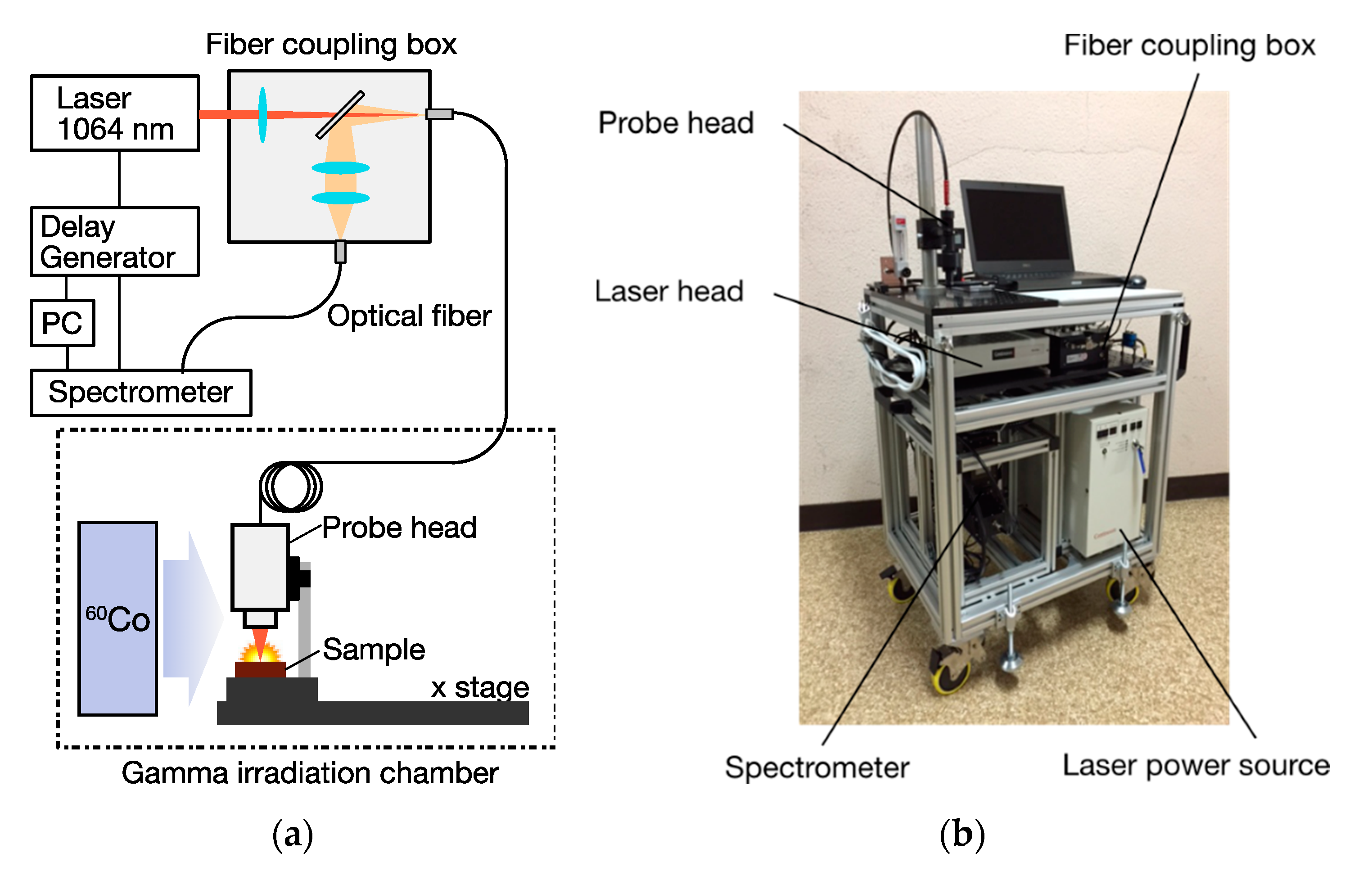
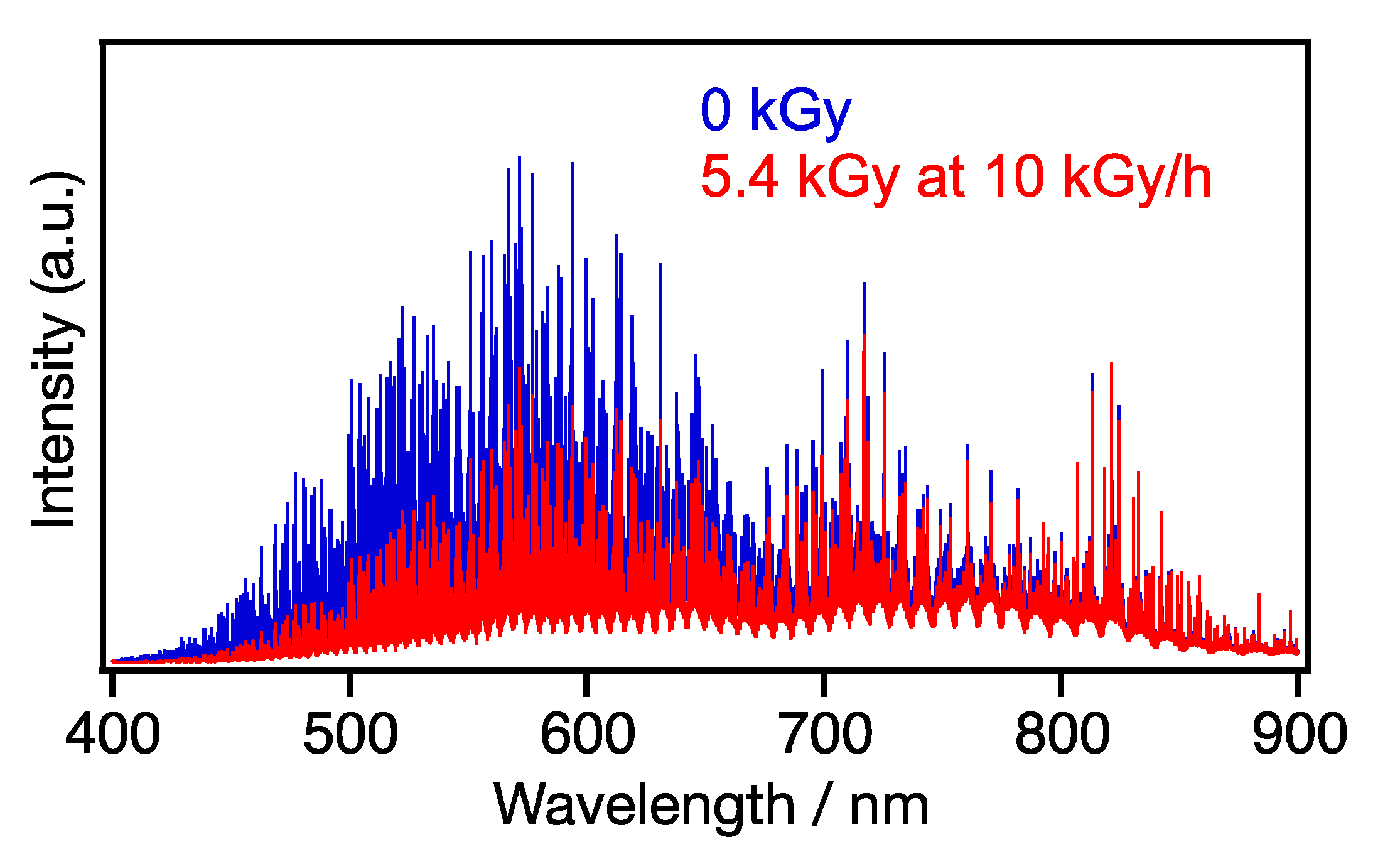
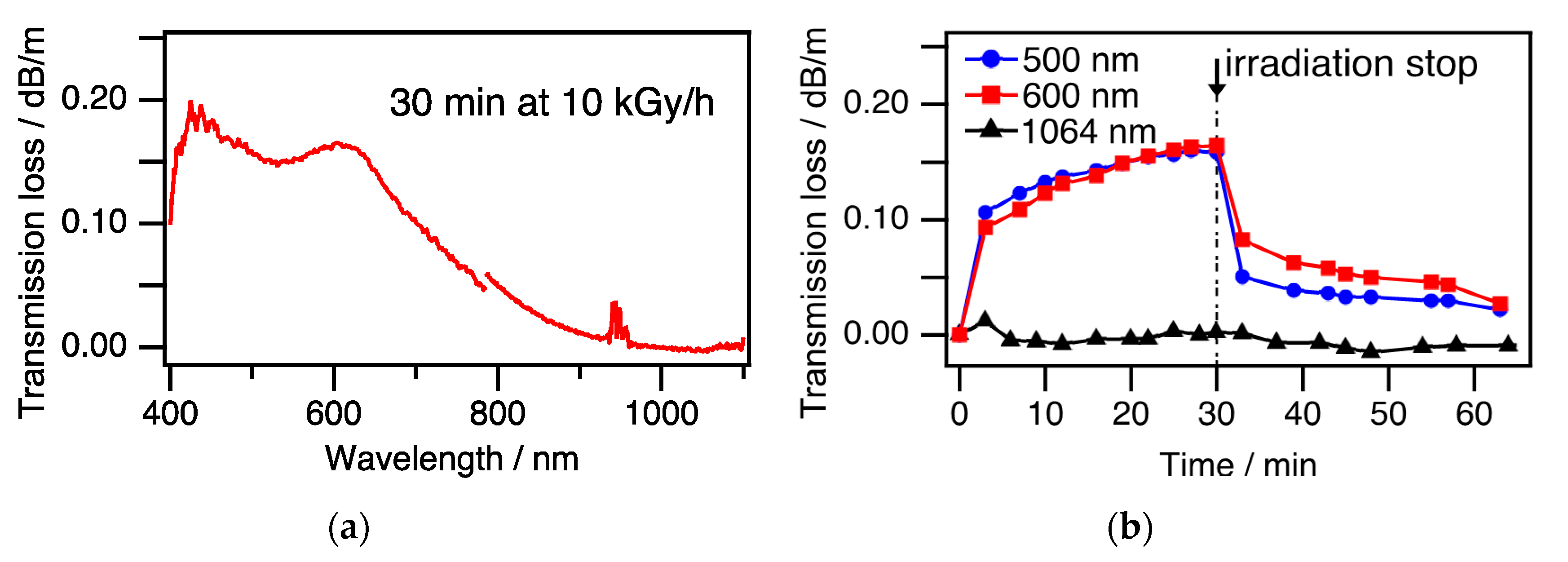
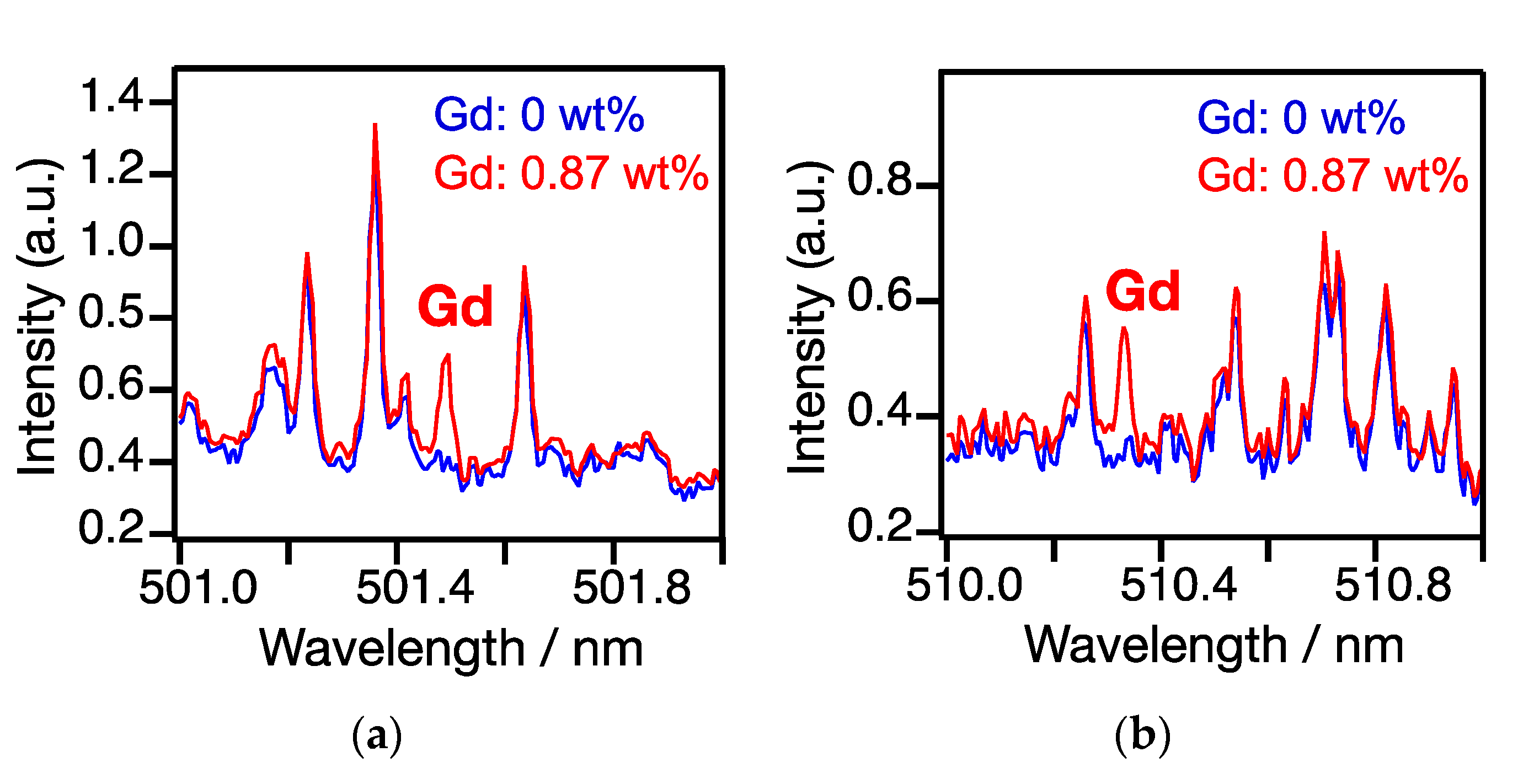
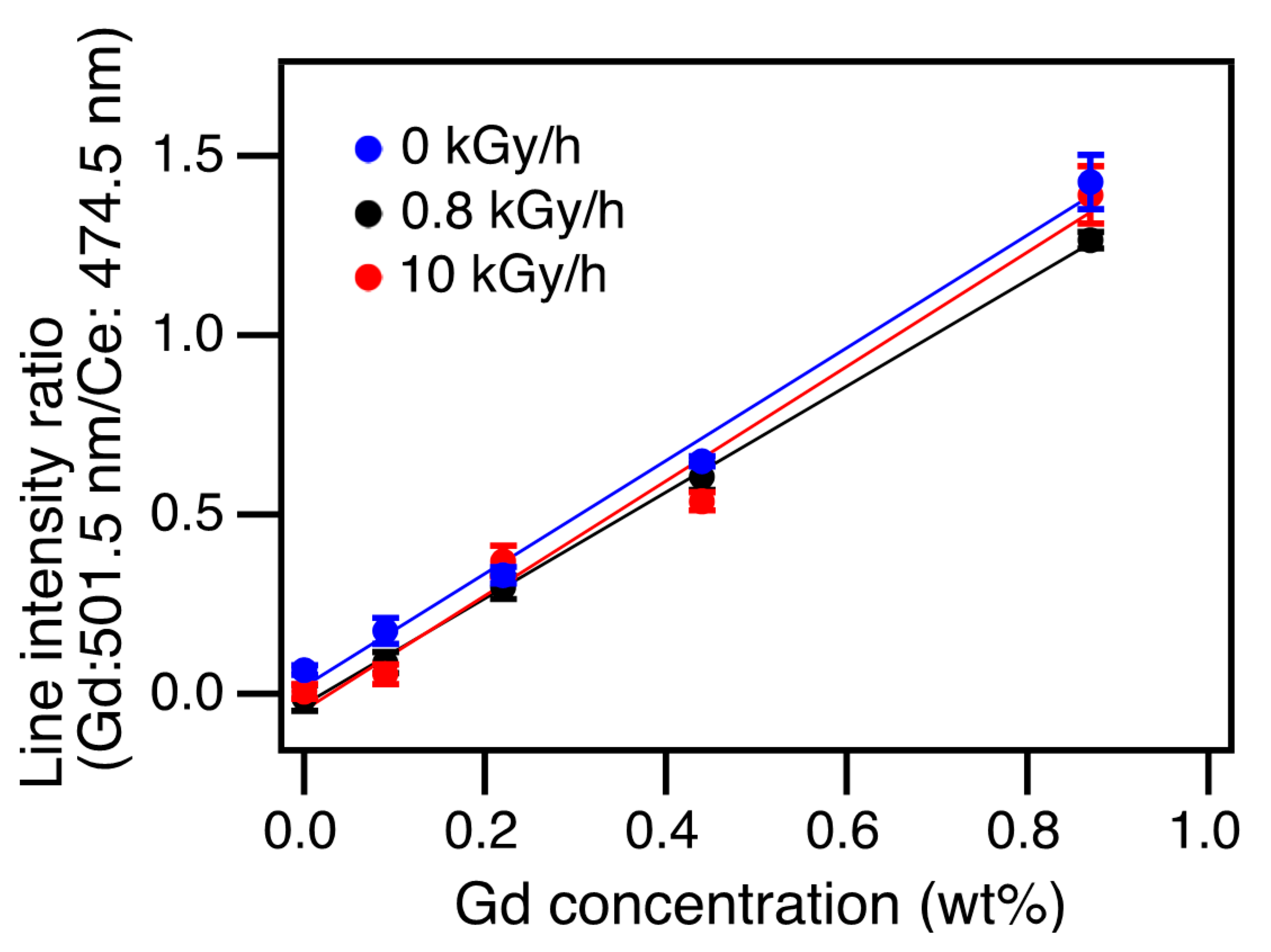
| Sample | Ce | Zr | Fe | Gd |
|---|---|---|---|---|
| #1 | 44.6 | 24.0 | 8.3 | 0.87 |
| #2 | 44.8 | 24.1 | 8.3 | 0.44 |
| #3 | 44.9 | 24.2 | 8.3 | 0.22 |
| #4 | 45.0 | 24.2 | 8.3 | 0.09 |
| #5 | 45.1 | 24.2 | 8.3 | 0.00 |
| Dose Rate (kGy/h) | R2 | b | a | LOD (wt%) |
|---|---|---|---|---|
| 0 | 0.993 | 1.573 | 0.020 | 0.027 |
| 0.8 | 0.999 | 1.481 | −0.031 | 0.075 |
| 10 | 0.980 | 1.595 | −0.045 | 0.039 |
Publisher’s Note: MDPI stays neutral with regard to jurisdictional claims in published maps and institutional affiliations. |
© 2020 by the authors. Licensee MDPI, Basel, Switzerland. This article is an open access article distributed under the terms and conditions of the Creative Commons Attribution (CC BY) license (http://creativecommons.org/licenses/by/4.0/).
Share and Cite
Nakanishi, R.; Saeki, M.; Wakaida, I.; Ohba, H. Detection of Gadolinium in Surrogate Nuclear Fuel Debris Using Fiber-Optic Laser-Induced Breakdown Spectroscopy under Gamma Irradiation. Appl. Sci. 2020, 10, 8985. https://doi.org/10.3390/app10248985
Nakanishi R, Saeki M, Wakaida I, Ohba H. Detection of Gadolinium in Surrogate Nuclear Fuel Debris Using Fiber-Optic Laser-Induced Breakdown Spectroscopy under Gamma Irradiation. Applied Sciences. 2020; 10(24):8985. https://doi.org/10.3390/app10248985
Chicago/Turabian StyleNakanishi, Ryuzo, Morihisa Saeki, Ikuo Wakaida, and Hironori Ohba. 2020. "Detection of Gadolinium in Surrogate Nuclear Fuel Debris Using Fiber-Optic Laser-Induced Breakdown Spectroscopy under Gamma Irradiation" Applied Sciences 10, no. 24: 8985. https://doi.org/10.3390/app10248985
APA StyleNakanishi, R., Saeki, M., Wakaida, I., & Ohba, H. (2020). Detection of Gadolinium in Surrogate Nuclear Fuel Debris Using Fiber-Optic Laser-Induced Breakdown Spectroscopy under Gamma Irradiation. Applied Sciences, 10(24), 8985. https://doi.org/10.3390/app10248985





